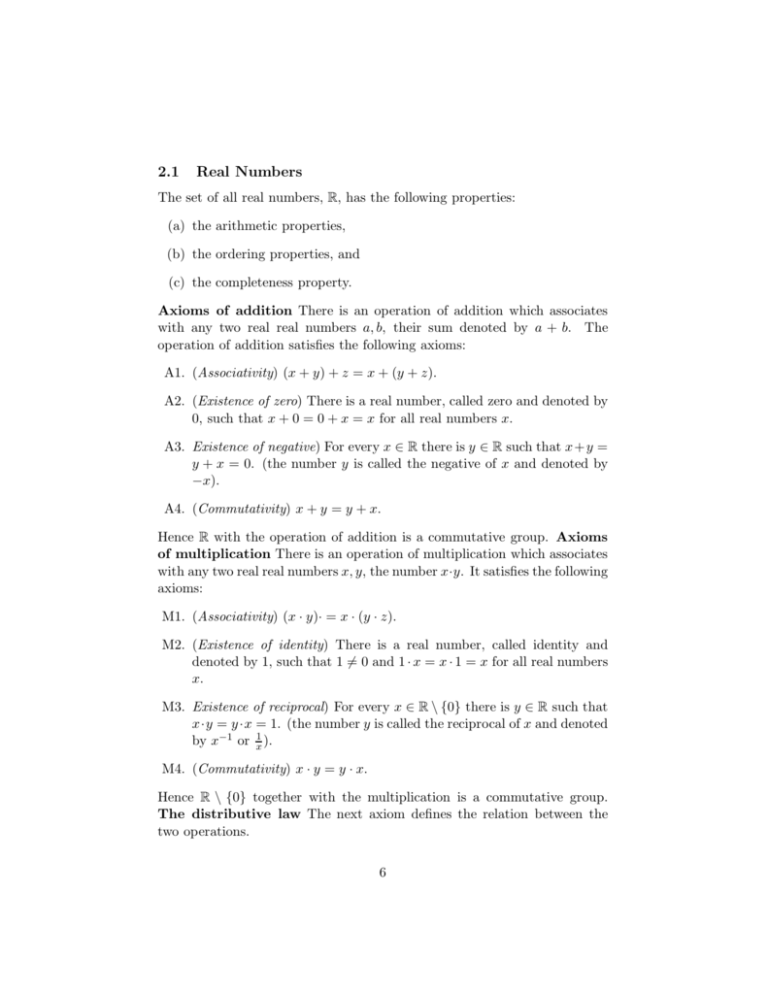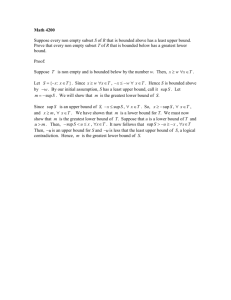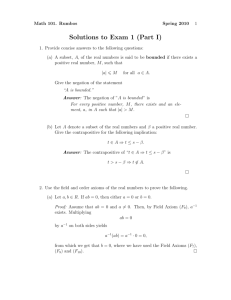2.1 Real Numbers
advertisement

2.1
Real Numbers
The set of all real numbers, R, has the following properties:
(a) the arithmetic properties,
(b) the ordering properties, and
(c) the completeness property.
Axioms of addition There is an operation of addition which associates
with any two real real numbers a, b, their sum denoted by a + b. The
operation of addition satisfies the following axioms:
A1. (Associativity) (x + y) + z = x + (y + z).
A2. (Existence of zero) There is a real number, called zero and denoted by
0, such that x + 0 = 0 + x = x for all real numbers x.
A3. Existence of negative) For every x ∈ R there is y ∈ R such that x+ y =
y + x = 0. (the number y is called the negative of x and denoted by
−x).
A4. (Commutativity) x + y = y + x.
Hence R with the operation of addition is a commutative group. Axioms
of multiplication There is an operation of multiplication which associates
with any two real real numbers x, y, the number x·y. It satisfies the following
axioms:
M1. (Associativity) (x · y)· = x · (y · z).
M2. (Existence of identity) There is a real number, called identity and
denoted by 1, such that 1 6= 0 and 1 · x = x · 1 = x for all real numbers
x.
M3. Existence of reciprocal) For every x ∈ R \ {0} there is y ∈ R such that
x·y = y ·x = 1. (the number y is called the reciprocal of x and denoted
by x−1 or x1 ).
M4. (Commutativity) x · y = y · x.
Hence R \ {0} together with the multiplication is a commutative group.
The distributive law The next axiom defines the relation between the
two operations.
6
D. x · (y + z) = x · y + x · z
All computational rules for reals follow from the axioms A1–A4, M1-M4, D.
Order There is a subset P of R, called the set of positive numbers, satisfying
the following two exioms:
O1. If x, y ∈ P , then x + y and x· ∈ P .
O2. For every x ∈ R, either x ∈ P or x = 0 or −x ∈ P .
The axioms O1 and O2 imply that 1 is a positive number. Indeed, since
1 6= 0, the axiom O1 implies that either 1 or −1 is positive. Since 1 =
1 · 1 = (−1) · (−1), the axiom O1 implies that 1 is positive. If x ∈ P , then
we write x > 0 and if −x ∈ P , we write x < 0. The notation x < y means
that y − x ∈ P . We also write x ≤ t to mean x < y or x = y. The order
properties of real numbers are as follows:
(a) x < y and y < z, then x < z.
(b) x < y and z > 0, then x · z < y · z.
(c) x < y and z ∈ R, then x + z < y + z.
(d) x < y and x, y > 0, then
1
y
< x1 .
A set X with two operations, addition and multiplication, which satisfy
axioms A1–A4, M1-M4, D, and O1-O2 is called an ordered field. The sets
of real numbers R and set of rational numbers Q are ordered fields. The
following axiom distinguishes between R and Q.
Continuity property
• Completeness property Every non-empty subset A ⊂ R that is
bounded above has a least upper bound, and that every non-empty
subset S ⊂ R which is bounded below has a greatest lower bound.
The following proposition gives a useful characterization of a least upper
bound.
Proposition 2.1. Let A ⊂ R be bounded above. Then a = sup A if and
only if x ≤ a for any x ∈ A, and for any ε > 0 there exists x ∈ A such that
a < x + ε.
7
Proof. Assume first that a = sup A. Clearly, x ≤ a for any x ∈ A. Take
ε > 0. If for all x ∈ A, x + ε ≤ a, then x ≤ a − ε for all x. Hence
a − ε is an upper bound of A contradicting the definition of a as the least
upper bound of A. Conversely, from x ≤ a for any x ∈ A follows that
a is an upper bound of A. Assume that there is an upper bound b of A
satisfying b < a. Takeε = a − b. Then by assumption there is x ∈ A so that
a < x + ε = x + (a − b). So, b < x contradicting that b is an upper bound
of A.
A similar characterisation of inf A is obtain by observing that if A is bounded
from below than the set −A = {x | −x ∈ A} is bounded from above and
that
sup(−A) = − inf A and inf(−A) = − sup A.
Proposition 2.2. Let A ⊂ R be bounded from below. Then a = inf A if and
only if a ≤ x for any x ∈ A, and for any ε > 0 there exists x ∈ A such that
x − ε < a.
2.2
Natural Numbers
Definition 2.3. A subset A of R is said to be inductive if
(1) 1 ∈ A.
(2) If x ∈ A, then x + 1 ∈ A.
Here are examples of some inductive subsets of R:
5
7
3
R, [1, ∞), Q,
1, , 2, , 3, , . . . .
2
2
2
Definition 2.4. The set T
of natural numbers N is the smallest inductive
subset of R. That is, N = {A ⊂ R| A is inductive}.
An easy consequence of the definition is the principle of mathematical
induction.
Proposition 2.5 (Principle of mathematical induction). Let A be a
subset of N such that 1 ∈ A and if n ∈ A, then n + 1 ∈ A. Then A = N.
Quite often the principle of mathematical induction is stated in the following form.
Proposition 2.6. Let n0 ∈ N and let S(n) be a statement for every natural
number n ≥ n0 . If
8
(a) S(n0 ) is true, and
(b) for each ∈ N satisfying n ≥ n0 , the statement S(n + 1) can be proved
assuming that S(n) holds true,
the S(n) is true for all natural numbers n ≥ n0
Proof. Define S := {n ∈ N| S(n − 1 + n0 ) is true}. Then 1 ∈ S since the
statement S(n0 ) is true. Assume that n ∈ S so that the statement S(n −
1 + n0 ) is true. Then from the assumption (a) it follows that the statement
S((n + 1) − 1 + n0 ) = S(n + n0 ) is true. So, n + 1 ∈ S. Consequently, the
subset S of N is inductive which implies that S = N.
The principle of mathematical induction is equivalent to the well-ordering
principle.
Proposition 2.7 (Well-ordering principle). The set N of natural numbers is well-ordered, that is, if A is a non-empty subset of N, then A has the
least element.
Proof. Arguing by contradiction we assume that there exists a subset A of
N without a minimum. Define a subset of N by
B = {n ∈ N| n is lower bound of A}.
The set B is nonempty since 1 is a lower bound of every subset of N. Assume
that n ∈ B. We claim that also n + 1 ∈ B. Indeed, since n is a lower bound
of A, we have that n ≤ a for all a ∈ A. But since A doesn’t have a minimum,
n doesn’t belong to A so that n < a for all a ∈ A. This implies that n+1 ≤ a
for all a ∈ A, i.e., n + 1 is a lower bound of A and it belongs to B. Summing
up, we have proved that 1 ∈ B and if n ∈ B, then n + 1 ∈ B. This means
that the set B is inductive and since it is a subset of N we conclude that
B = N. This leads to contradiction as follows. Take some element m ∈ A
(recall that A is nonempty). Then m ∈ B since we proved that B = N.
Hence m is a lower bound of A and since it belongs to A, the element m has
to be a minimum of A, contradiction.
To see that well-ordering implies the principle of mathematical induction
assume that A is subset of N having properties as in Proposition 2.5. Arguing
by contradiction assume that A 6= N. Hence N \ A is nonempty. Let m be
the minumum of N \ A. Then m ≥ 2 since 1 ∈ A. Hence m − 1 6∈ N \ A.
This means that m − 1 ∈ A. But then m = (m − 1) + 1 ∈ A by the property
of the set A. This gives a contradiction with m ∈ N \ A.
9
Proposition 2.8 (Archimedian Property). Given a real number x there
exists an integer n ∈ N such that x < n.
Proof. Assume not. Then there exists x ∈ R such that n < x for all n ∈ N.
This means that the set of integers N is bounded from above. Since the set N
is nonempty (1 ∈ N), the completeness axioms implies that a := sup N ∈ R.
Applying Proposition 2.2 with ε = 1, we find m ∈ A satisfying m ≤ a ≤
m + 1. Since m + 1 ∈ N we obtain contradiction with the fact that a is an
upper bound of N.
Corollary 2.9. If x > 0, then there exists n ∈ N such that n − 1 ≤ x < n.
Proof. We may assume that x > 1. Define the set A = {k ∈ N| x < k}. By
the Archimedian Property, A is nonempty. By the well-ordering principle,
there is n ∈ A such that n ≤ k for all k ∈ A. Then n − 1 ≤ x < n.
Proposition 2.10 (Density of Q in R). If x and y are real numbers
satisfying x < y, then there is r ∈ Q such that x < r < y.
Proof. We may assume that x > 0. By the Archimedian property, there
1
< n. Hence 1 < ny − nx. By Corollary 2.9,
is n ∈ N such that 0 < y−x
there is m such that m − 1 ≤ nx ≤ m. This implies that x < m
n . Since
m ≤ nx + 1 < nx + (ny − nx) = ny, m
<
y.
Hence
the
proposition
follows
n
m
by taking r = n .
√
Proposition 2.11 (Existence of 2). Given a > 0, there exists a unique
b > 0 such that b2 = a.
Proof. Without loss of generality we may assume that a > 1 (if not we
consider 1/a). Set A = {x > 0| x2 < a}. Since 12 = 1, it follows 1 ∈ A
so that A 6= ∅. In addition 1 < a, implies that x < a for all x ∈ A.
Consequently, the set A is bounded above and since it is nonempty, there
exist b = sup A. We claim that b2 = a. Assume not. Then either b2 < a
or a < b2 . Consider the first case. Since (a − b2 )/(2b + 1) > 0, we find
n ∈ N such that (a − b2 )/(2b + 1) > 1/n (this follows from the Archimedian
property). Then (b + 1/n)2 = b2 + 2b/n + 1/n2 < b2 + (2b + 1)/n < a.
However, this implies that b + 1/n ∈ A contradicting that b = sup A. Now
assume that a < b2 . Then (b2 − a)/(2b) > 0 and we find n ∈ N so that
(b2 − a)/(2b) > 1/n. Then (b − 1/n)2 = b2 − 2b/n + 1/n2 > a + 1/n2 > a.
This implies that b − 1/n > x2 for all x ∈ A so that b − 1/n is an upper
bound of A contradicting that b = sup A. Hence b2 = a as claimed.
10








